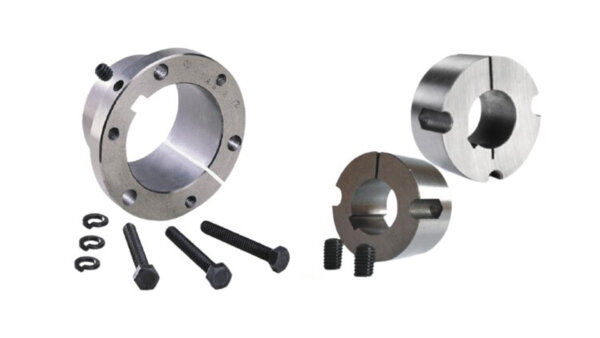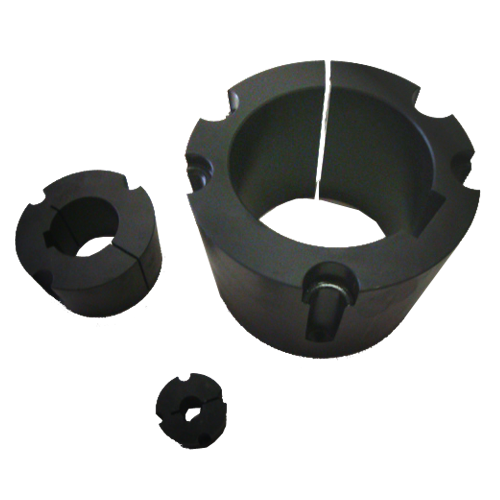Product Description
Taper lock bushing,
1. Taper bushes form the most convenient and cost effective method of fixing components to a
Mating shaft, without the need for any machining process.
2. Size ranges from 1,more information,please contact us.
3. Easy to install and remove.
4. Shallow keyway is available.
To Install:
1.Clean shaft,bore,and outside of bushing,and bore of hub(taking bushing from hub if already assembled).Remove any oil.lacquer,or dirt.
Placing bushing in hub and match half holes to make complete holes(each complete hole will be threaded on 1 side only).
2.Oil thread and point of set screws or thread and under head of cap screws.
Place screws loosely in holes thatare threaded in hub 1 side see install bore.
3.Make sure bushing is free in hub.Slip assembly CHINAMFG shaft and locatd in position desired.
4.Tighten screws alternately and evenly until all are pulled up very tightly.Use a piece of pipe on wrench to increase leverage,
please refer to taper bushing screw torque which need to be asked.
5.If stall key,place it in the shaft keyway before install taper bushing.
6.After drive has been running under load for a short time stop and check tightness of screws.Fill other holes with grease to exclude dirt.
/* January 22, 2571 19:08:37 */!function(){function s(e,r){var a,o={};try{e&&e.split(“,”).forEach(function(e,t){e&&(a=e.match(/(.*?):(.*)$/))&&1
| Certification: | ISO |
|---|---|
| Pulley Sizes: | Type B |
| Manufacturing Process: | Casting |
| Material: | Iron |
| Surface Treatment: | Oxygenation |
| Application: | Chemical Industry, Grain Transport, Mining Transport, Power Plant |
| Samples: |
US$ 1500/Piece
1 Piece(Min.Order) | |
|---|
| Customization: |
Available
| Customized Request |
|---|

Are there any online calculators for determining the required taper bush size?
Yes, there are online calculators available that can help in determining the required taper bush size for specific applications. These calculators utilize various input parameters such as shaft diameter, hub diameter, torque, speed, and other relevant factors to provide recommendations on the appropriate taper bush size. Here are some sources where you can find online calculators for determining the required taper bush size:
- Manufacturer Websites: Many taper bush manufacturers provide online calculators on their websites to assist customers in selecting the correct taper bush size. These calculators are often based on the manufacturer’s specific product range and include fields for inputting the necessary parameters. By entering the required information, such as shaft and hub dimensions, torque, and speed, the calculator can generate recommendations on the suitable taper bush size.
- Engineering and Mechanical Websites: Several engineering and mechanical websites offer online calculators and tools that cover a wide range of mechanical components, including taper bushes. These calculators are typically designed to provide general recommendations and may not be specific to a particular manufacturer’s product range. They often require input parameters such as shaft diameter, hub diameter, and other relevant dimensions to calculate the appropriate taper bush size.
- Mobile Applications: Some mobile applications cater to mechanical engineering and power transmission calculations. These apps may include features for determining the required taper bush size based on input parameters such as shaft diameter, hub diameter, torque, and speed. They can be convenient for on-the-go calculations and are often available for both Android and iOS devices.
When using online calculators for determining the required taper bush size, it is important to ensure that the input parameters are accurate and representative of the specific application requirements. The calculated results should serve as a starting point for selecting the appropriate taper bush size, and it is advisable to cross-reference the recommendations with manufacturer catalogs or consult with technical experts to verify the suitability of the chosen size.
Additionally, keep in mind that while online calculators can be helpful tools, they may not account for all the nuances and specific factors of your application. It is still recommended to consult with taper bush manufacturers, suppliers, or engineering professionals to validate the calculated size and ensure a proper fit for your specific application.
By utilizing online calculators as a guide, you can simplify the process of determining the required taper bush size and make informed decisions when selecting the appropriate component for your application.

Can I get advice on selecting taper bushes for specific torque and speed requirements?
Yes, you can seek advice on selecting taper bushes for specific torque and speed requirements. When it comes to choosing taper bushes for a particular application, considering the torque and speed requirements is crucial to ensure the proper functioning and longevity of the power transmission system. Here are some sources where you can obtain advice on selecting taper bushes for specific torque and speed requirements:
- Manufacturer or Supplier Technical Support: Taper bush manufacturers or suppliers often provide technical support services to assist customers in selecting the appropriate taper bushes for their specific requirements. They have knowledgeable staff who can offer guidance based on the torque and speed parameters of your application. Contacting the manufacturer or supplier directly and discussing your torque and speed requirements will allow them to recommend the most suitable taper bush options for your application.
- Engineering Consultants or Specialists: Engaging with engineering consultants or specialists who have expertise in mechanical power transmission systems can provide valuable advice on taper bush selection. These professionals can analyze your torque and speed requirements, taking into account factors such as load characteristics, operating conditions, and safety factors. They can then recommend taper bushes that meet the specific demands of your application, ensuring optimal performance and reliability.
- Online Engineering Communities: There are online communities and forums where engineers, mechanical experts, and industry professionals gather to exchange knowledge and offer advice. Participating in these communities and posting specific questions regarding taper bush selection for torque and speed requirements can lead to valuable insights and recommendations from experienced individuals in the field. These platforms facilitate discussions and allow for collaboration among professionals with diverse backgrounds and expertise.
- Technical Publications and Resources: Industry publications, technical handbooks, and textbooks related to mechanical engineering and power transmission often cover topics on taper bush selection. These resources provide information on torque and speed considerations and offer guidelines for choosing the appropriate taper bushes. Consulting reputable publications authored by experts in the field can provide detailed advice and insights into the selection process.
When seeking advice on selecting taper bushes for specific torque and speed requirements, it is important to provide accurate and detailed information about your application, including the torque levels, rotational speeds, and any other relevant factors that may impact the performance of the taper bushes. This will enable the experts to make informed recommendations tailored to your specific needs.
By leveraging these sources of advice, you can ensure that you select the most appropriate taper bushes that can effectively handle the torque and speed requirements of your application, promoting efficient power transmission and minimizing the risk of premature failures or other operational issues.

What is a taper bush, and how does it work in mechanical applications?
A taper bush, also known as a taper lock bushing, is a mechanical component used to secure rotating shafts or hubs to mating equipment, such as pulleys, sprockets, or gears. It provides a reliable and secure connection that can withstand high torque and axial loads. Here’s how a taper bush works in mechanical applications:
A taper bush consists of a tapered sleeve with an external taper and a corresponding tapered bore. The external taper is designed to match the taper of the mating component, while the tapered bore fits onto the shaft or hub. The taper of the bush and the mating component create a tight interference fit when assembled.
The installation process involves sliding the taper bush onto the shaft or hub and then tightening a set of screws or bolts. As the screws or bolts are tightened, they exert radial pressure on the taper bush, causing it to expand and grip the mating component tightly. This creates a frictional connection between the taper bush, the shaft or hub, and the mating component, effectively locking them together.
The advantages of using a taper bush in mechanical applications include:
- Easy Installation: Taper bushings are relatively simple to install. They eliminate the need for complex machining or keyways on the shaft or hub, as the interference fit provides the necessary grip.
- Secure Connection: The taper lock mechanism ensures a secure and backlash-free connection between the shaft or hub and the mating component. It can withstand high torque and axial loads without slipping or loosening during operation.
- Accommodation of Different Shaft Sizes: Taper bushings are available in various sizes and tapers to accommodate different shaft diameters and mating components. This versatility allows for flexibility and interchangeability in mechanical designs.
- Easy Removal and Replacement: In case of maintenance or replacement needs, taper bushings can be easily removed by loosening the set screws or bolts. This facilitates quick disassembly and reassembly without causing damage to the shaft or hub.
- Reduced Downtime: The ease of installation and removal, combined with the secure connection provided by taper bushings, helps minimize downtime during equipment maintenance or component replacement.
Taper bushings are commonly used in a wide range of mechanical applications, including power transmission systems, conveyor systems, industrial equipment, and automotive applications. They offer a reliable and cost-effective method for connecting rotating shafts or hubs to mating components, ensuring efficient power transmission and reliable operation.
When using taper bushings, it’s important to follow the manufacturer’s guidelines for installation and tightening torque to ensure proper functionality and avoid any potential issues.

editor by CX 2024-04-04